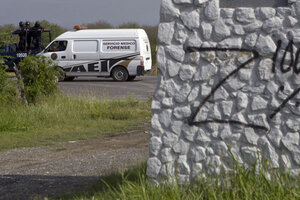Massacre in Mexico deepens country's violent image
Forty-nine bodies were dumped on a highway in northern Mexico in the latest example of drug-related violence that is scaring off investors and changing citizens' behavior at home.

Mexican federal police and forensic investigators at the site where bodies were found on the highway between Monterrey, Mexico and the US border.
Christian Palma/AP
Mexico City
Forty-nine bodies have been dumped on a highway in northern Mexico – and by the time the world wakes up Monday morning, the harrowing image will have been beamed across the globe.
Mexico's drug violence has been a public relations nightmare for President Felipe Calderon. The crime scenes inevitably make world news, scaring off would-be tourists and causing foreign investors to think twice.
But imagine being a resident of one of the cities where violence is playing out, with the misfortune to witness the mayhem not on a television set but firsthand.
That is what happened to Carolina Gomez, a young teacher who happened to drive past a similar scenario in her home of Veracruz, in eastern Mexico, when 35 bodies were left under a highway overpass in the middle of rush hour traffic last September. She had been on her way to a tutoring job after school.
The Monitor profiled her family in a cover story about the ways that violence is impacting Mexicans not directly swept up in it.
The dumping of the bodies was a tipping point for the city of Veracruz, but also in the personal story of Ms. Gomez. As a teacher, she had heard cases of parents kidnapped, and even seen a corpse left outside of her school. She had to take security training on what to do in the case of a shootout. And she never left home – including on this day – without checking Twitter first to map out safe routes.
But this scene caught her off guard. And it forever changed the way she viewed her city. It was the afternoon. It was on a heavily trafficked thoroughfare. It was next to an upscale mall and movie theater. “It made me feel like no place was safe,” she told the Monitor.
In this most recent case, the victims, who were first mutilated and included six women, were found near Monterrey, on a highway that heads to the US border. The identity of the victims is not yet known. The scenario fits the patterns of drug trafficking rivals, though the Nuevo Leon state Attorney General Adrian de la Garza told the Associated Press the victims could also be migrants who were en route to the US. The deadly Zetas gang, also behind the surge of violence in Veracruz, purportedly took credit for the act in a banner left at the scene.
As was the case in Veracruz, where hundreds of commuters passed by the scene, surely public officials and first-responders were not the only ones to bear witness.
Both incidents – while among the worst in President Calderon's six-year war on drugs – is sadly not isolated. In this month alone, 23 bodies have been either strewn or hanging off bridges and underpasses in the border city of Nuevo Laredo. Across the country, in Guadalajara, 18 more were also found on a highway. Police officers have been killed and piled up on public roads in Michoacan. The list could take up this entire space.
The Mexican government takes great pains to explain to the world that violence is, in most ways, contained. They say the far majority of victims are rival drug traffickers, not innocent victims. And the violence tends to play out in hot spots, not in the humdrum communities of Mexico, and especially, they say, not in places that tourists would want to go, such as Cancun.
But events like that in Monterrey make it hard for Mexico to erase its image, no matter how many statistics are thrown out there. And the numbers mean next to nothing to those who are living in the violent context. In a national survey headed by Mexican researchers last year, 61 percent of Mexicans said they stopped going out at night; 30 percent say they no longer drive the state or national highways because of fear of drug trafficking violence; 22 percent said they stopped going to public events like concerts or sport events.
If there is an upside to living where the streets no longer feel safe, it is a sense of community that has formed where there was once none. Gomez said she walked into her student's home pale-faced last September, and was handed a glass of water. She quietly told the child's mother what had just happened – away from young ears– and the mother, whom she barely knew, offered her a ride home so that she wouldn't have to drive alone. It was a small act of kindness but one that she remembers months later. “Strangers have turned to one another for help because of all of this,” she said.

